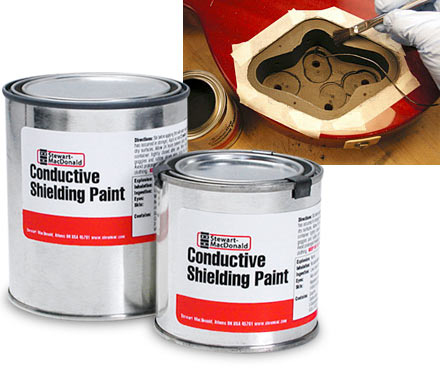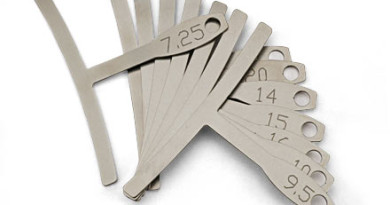Conductive Shielding Paint
Does your guitar buzz or hum? Or perhaps it doesn’t… or perhaps it’s not all that bad. You don’t have to be a gigging player to end up exposed to changes in your playing environment that could introduce some interference into your rig. Be it to address an existing issue or to take some preventative measures… let’s talk about conductive shielding paint.

Some people use shielding tape, and I do that too. After reading and hearing about conductive shielding paint, I wanted to give it a go. But I also know some people that cover the bases by doing both. There’s a school of thought that certain types of shielding can cover different frequency ranges and applying paint and different types of tape will better handle the issue. That’s a conversation for a different time, but I thought I’d still mention it for anyone that wanted to look it up, do the research and see what’s best for them.
Test Subjects
For this experiment, I’m dealing with a few guitars that cover a few levels of shielding. One guitar has no prior shielding. Another has some existing shielding paint. A third is partially shielded with shielding tape. And so on. In all instances where there is a cavity cover, it is already shielded with shielding tape.
There are plenty of outlets for shielding paint. I went with the Conductive Shielding Paint from StewMac. I know I’m shielding a few guitars and the cost per ounce works out to be worth it for me. It should be easy to find options that work for your needs, based on the amount required for your project.
It’s so simple
Even I cannot screw it up. HaHa! Get a brush and apply it. It might be a good idea to lightly rough up the surface with some sandpaper, so determine your needs accordingly. Most people prefer to mask off the area, and I do that too. Sometimes I don’t. I like to let it dry for a full day before the next step. In some cases, I felt it might do good with a 2nd coat. A 3rd coat doesn’t hurt eithter. If you want to nerd out, you can always use your multimeter to confirm conductivity.

What do you cover?
Well… where do you have electronics and what do you have that is conductive? In an extreme instance, coverage extends to the control cavity, the pickup cavities, the tremolo cavity and up and in to the trem recess cavity. The trem cavities? Yep. I wanted to give it a shot. It was an idea one builder explained to me, where the bridge/trem are contact points for grounding… so apply the coverage to the trem posts all the way around the claw posts.
For the wiring holes between the cavities, I used Q-Tips, but I’ve seen some people use those fuzzy pipe cleaner things (I dunno, ask your wife or kids what they are – lol!). The Q-Tips worked for me, as I could snip off the cotton ends and use the stick to apply down inside the screw holes for the trem claws.
Demo
Here’s a video of Dan Erlewine going through some steps he uses to shield a Strat pickup cavity:
Does it work?
Yep. On some of the more extreme applications of the conductive paint, it was like you always want your rig to be… a totally blasted out high gain amp channel and hardly a difference when you take your hands off the hardware. For perspective, this was in a room with fluorescent lights and a myriad of other interference issues. None of the guitars tests were problematic in this area, but the shielding paint took it up a notch. There are many steps along the way to keeping buzz out of your rig.
During a recent build, I’m seeing that my old can of Shielding Paint is looking a little funky inside. Before buying a new can, I take a second to actually read the label. Imagine that! LOL! Sure enough, it literally says to thin with water if evaporation occurs. So this same one can has been lasting for years, making it a very safe investment.
7 string 16Ω 59 Airbucker Alnico 2 Alnico 4 Alnico 5 Alnico 8 Bare Knuckle BKP Boot Camp Brown Sound Celestion Ceramic Custom Shop David Shepherd DiMarzio Dual Resonance EVH Fishman Floyd Rose Fluence Gibson HSP90 Humbucker Ibanez JB Jimmy Page John Petrucci Les Paul MJ Mojotone P90 PAF Pariah Pickup Satch Seymour Duncan Singlecoil Single Width Speaker Steve Vai Tech Tip Tremolo Virtual Vintage




